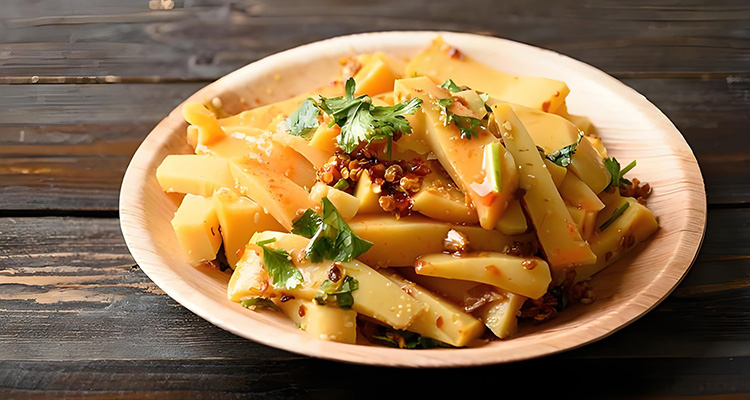Wantuo: Millennia-old Shanxi Buckwheat Traditional Chinese Snack
In the alleys and streets of Shanxi, a humble snack carries centuries of history and local flavor: Wantuo. Made from buckwheat, it can be enjoyed cold for a refreshing bite or stir-fried hot for a rich, savory experience. Each mouthful is a taste of the Loess Plateau. Join this culinary journey to discover Wantuo’s unique charm.
1. Historical Origins: A Food Born in the Western Jin Camps
Wantuo’s origins trace back to the early Western Jin (circa 3rd century). During times of migration and conflict, Xiongnu people moved inland and faced harsh oppression. Their leader Liu Yuan sent general Shi Le—who later founded the Later Zhao—to fight. Facing food shortages, troops ground local buckwheat into flour, cooked it into a porridge, and found that when cooled it set into slices. Portable and filling, these slices became the earliest form of Wantuo, a resourceful wartime invention that lived on after Shi Le’s era and spread throughout the region.
2. Cultural Significance: A Living Trace of Shanxi Life
In Shanxi—especially in the Lvliang and Xinzhou regions—Wantuo is more than a snack; it’s a cultural emblem. Locals call it by many dialect names: “wan tu”, “wan tuo”, “wan tuozi”, reflecting regional affection. Wantuo appears at street stalls, family tables, and festivals, symbolizing the resilience and creativity of Loess Plateau communities. Overseas Shanxi natives often seek it out first when returning home; it connects generations and memories, turning food into a tangible link between past and present.

3. Ingredients and Preparation: Buckwheat’s Transformation
Buckwheat flour is the core ingredient—nutritious, high in protein and fiber, and easy to digest. The preparation looks simple but requires technique. Mix buckwheat flour with water into a smooth batter, then cook slowly with hot water while stirring until it becomes a porridge-like paste. Proper heating is crucial: too hot and it scorches, too cool and it won’t set. Pour the paste into shallow bowls and let it cool and firm naturally into bowl-shaped loaves. The finished Wantuo is pale gray-white, tender yet resilient, carrying the natural aroma of buckwheat without additives.
4. Flavor and Texture: Versatile Hot and Cold Experiences
Wantuo’s appeal lies in its textural and flavor versatility. Served cold, it’s smooth, slightly chewy, and lightly fragrant—somewhat like chilled starch jelly but with more bounce. Stir-fried hot in pork lard, it develops a crisp exterior and a soft interior, releasing savory aromas. The condiments make the dish: aged Shanxi vinegar for acidity, fresh garlic for bite, and house chili oil for fragrant heat. Together they balance the buckwheat’s rich notes into a savory, tangy, and slightly spicy profile. This hot-or-cold duality makes Wantuo suitable year-round—cool in summer, warming in winter.

5. How to Eat It: The Art of Street-Style Tasting
Street vendors typically serve Wantuo in shallow bowls. Before eating, vendors score the loaf with a small knife into squares or strips to allow the sauces to penetrate. They then pour on a dressing of aged Shanxi vinegar, mashed garlic, and bright red chili oil—sometimes garnished with cilantro or scallions. Diners pick pieces up with a bamboo skewer or mix them in the bowl. Many enjoy the dish standing at a stall, soaking in the lively street atmosphere. Hot stir-fried Wantuo is often cooked to order with bean sprouts or greens, making it a great snack, side, or accompaniment to local drinks.
6. Tasting Tips: Enjoying Wantuo Like a Local
For an authentic experience, try Wantuo two ways: start cold, then try the hot stir-fried version. When eating it cold, taste the buckwheat base first and add vinegar gradually to appreciate the balance. For stir-fried Wantuo, choose versions fried in pork lard for contrast between a crispy outside and tender center. Pair with Shanxi huangjiu (yellow wine) or brick tea to mellow the spice. Wantuo portions are modest—enjoy it with other Shanxi specialties like knife-cut noodles or Pingyao beef. Visit vendor stalls in the afternoon or evening when they’re freshest, and tell the vendor your preferred spice level.

7. Visitor Tips: Where to Find Authentic Wantuo
Authentic Wantuo is most common in Lvliang (Lishi, Liulin) and Xinzhou (Baode, Hequ) old quarters. Taiyuan food streets and Pingyao Ancient City also offer it—choose busy, established stalls or time-tested shops. Expect prices around CNY 5–10 per bowl. Look for places with visible preparation, clean utensils, and steady queues. Spring and autumn are ideal travel seasons for comfortable weather. When attending regional events like temple fairs, try local Wantuo variations for unique flavors.
8. Homemade Simple Recipe: Recreate Shanxi Flavor at Home
If travel isn’t possible, try a simple home version. Ingredients: 200g buckwheat flour, 500ml water, pinch of salt. Mix flour and cold water into a smooth batter, then pour into boiling water while stirring; simmer on low for about 10 minutes until thick. Pour into oiled shallow bowls, cool and chill until set, then cut into pieces. Dressing: 2 tbsp aged Shanxi vinegar, 1 tbsp mashed garlic, 1 tbsp chili oil, cilantro to taste. For stir-fry: heat pork lard in a pan, fry Wantuo pieces until golden, add dressing and toss. This home approach captures the essential flavors for sharing with friends.
Conclusion
Wantuo is more than street food; it’s a compact history of Shanxi. Food lovers and cultural explorers alike should add this buckwheat specialty to their Shanxi itinerary. On your next trip, let Wantuo’s flavor guide you through a taste of this ancient region.



